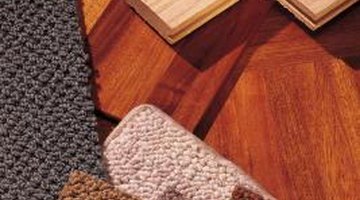The Best Ways to Store Hardwood Flooring
Building and remodeling a home is a time-consuming process that can become even longer when little problems arise. If your building project exceeds the original time frame you may need to store some of your building materials like hardwood flooring. Hardwood flooring is extremely susceptible to water, weather and heat damage so it must be stored properly in order for it to be viable for use when you need it. If you make the effort to store your flooring properly, you can avoid having to deal with damage or replacements later.
Properly Enclosed Spaces

While it may be OK to leave hardwood flooring outside or in the garage under a tarp for a few days during installation, these conditions are not acceptable for long-term storage. Flooring must be kept in a properly enclosed building that has a secure roof and weatherproof windows. Extreme temperatures and excess moisture can irreparably damage hardwood flooring so it is important to select a building that will protect your flooring from exposure to the elements.
Climate Control and Circulation
If hardwood flooring is exposed to freezing temperatures or extreme heat, it may end up cracking or warping, which makes it useless to you as a builder. In order to prevent this damage, speak to the manufacturer about what temperature is ideal for storing the particular type of flooring you have and do what you can to control the temperature in your storage building. Hardwood flooring needs to be kept clean and dry, so air circulation is also a concern. Clean air should be allowed to circulate among the stacks of flooring; you may need to install fans if your building has poor air flow.
Humidity Control
When storing hardwood flooring, preventing moisture condensation is a big concern. When the temperature inside the storage unit is warmer than the temperature outside, the moisture in the air may begin to condene on the underside of the roof. Stacks of flooring should be covered with plastic film to protect them from moisture. While too much moisture is certainly a problem, too little moisture can cause damage as well. Removing too much humidity from the building may bring the flooring below its manufactured moisture content, which could result in buckling when the flooring is installed.
Stock Rotation
If you are storing a large quantity of hardwood flooring and do not plan to use it all during one project, it is best to rotate the stock. Organize your stock by the date in which it was brought into the warehouse and use up the older flooring first. Give all flooring time to acclimate, however, because newly manufactured flooring may contain excess moisture and it typically shrinks as it acclimates. Never store new flooring on top of old flooring because the different moisture content of the newer flooring may damage the older flooring.
References
Writer Bio
Katherine Barrington has written on a variety of topics, from arts and crafts to pets, health and do-it-yourself projects. She has a Bachelor of Arts in English with a creative writing concentration from Marietta College.
Photo Credits
- Comstock/Comstock/Getty Images
More Articles



